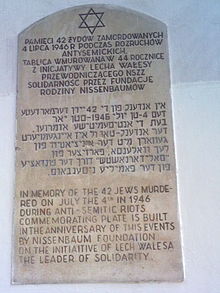Kielce pogrom
| Kielce pogrom | |
|---|---|

Memorial plaque at the house on Planty 7 in Kielce dedicated by Lech Wałęsa in 1990
|
|
| Location | Kielce, Poland |
| Date | 4 July 1946 Morning until evening (official cessation at 3 p.m.) |
| Target | Polish Jews |
| Deaths | 38 to 42 |
The Kielce Pogrom was an outbreak of violence against the Jewish community centre's gathering of refugees in the city of Kielce, Poland on 4 July 1946 by Polish soldiers, police officers, and civilians which resulted in the killing of 42 Jews and while over 40 were wounded. Polish courts later tried and executed nine of the attackers in connection with the incident.
As the deadliest pogrom against Polish Jews after the Second World War, the incident was a significant point in the post-war history of Jews in Poland. It took place only a year after the end of the Second World War and the Holocaust, shocking Jews in Poland, Poles, and the international community. It has been considered a catalyst for the flight from Poland of most remaining Polish Jews who had survived the Holocaust.
During the German occupation of Poland, Kielce was completely ethnically cleansed by the Nazis of its pre-war Jewish population. By the summer of 1946, some 200 Jews, many of them former residents of Kielce, had returned from the Nazi concentration camps, the Soviet Union, and other places of refuge to live there. About 150-160 of them were quartered in a single building administered by the Jewish Committee of Kielce Voivodeship at Planty, a small street in the centre of the town.
On 1 July 1946, an eight-year-old Polish boy, Henryk Błaszczyk, was reported missing by his father Walenty Błaszczyk. According to the father, upon his return two days later the boy claimed he had been kidnapped by an unknown man, allegedly a Jew or a gypsy. Two days later, the boy, his father and the neighbour went to a local police station. While passing the 'Jewish house' at 7 Planty Street, Henryk pointed at a man nearby who, he said, had allegedly imprisoned him in the house's cellar. At the police station, Henryk repeated his story that he had been kidnapped and specified the Jews and their house as involved in his disappearance. A police patrol of more than a dozen men was then dispatched on foot by the station commander Edmund Zagórski to search the house at 7 Planty Street for the place where Henryk had allegedly been kept.
...
Wikipedia
